Opinion
artnet News Critics’ Picks: The Most Memorable Artworks of 2016
artnet News' editors and contributors pick their favorites from a year's worth of memorable art.
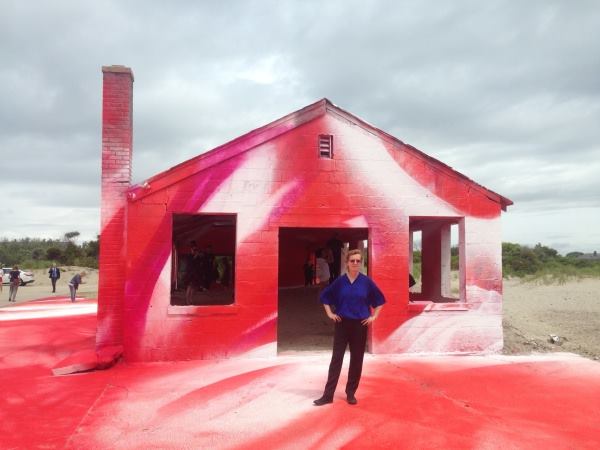
artnet News' editors and contributors pick their favorites from a year's worth of memorable art.

Artnet News

While 2016 may have been pretty awful on any number of fronts, we have to admit that it also gave us a lot of pretty great art. Consider Maurizio Cattelan alone, who gave us a solid gold toilet to relieve ourselves on at New York’s Guggenheim Museum, a real life donkey, pooping in the tent at Frieze New York, and a wheelchair gliding on water (more or less) at Manifesta 11 in Zurich.
From the politically-engaged, to the absurdly-outlandish, to the transcendentally-beautiful, here are the works that have stuck in artnet News’s mind as 2016 draws to an end.
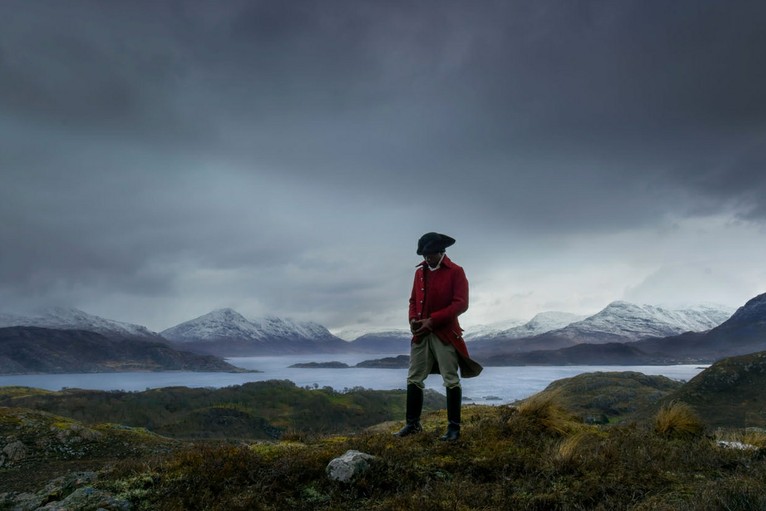
John Akomfrah, Vertigo Sea (2015). © Smoking Dogs Films. Courtesy of Lisson Gallery.
John Akomfrah, Vertigo Sea (2015), Arnolfini Gallery, Bristol, UK
January 16–April 10, 2016
John Akomfrah’s oneiric meditation on death-by-water seduced with its lush camerawork and hypnotic soundscape, even as it chilled to the marrow with its subject matter. While by no means a straight-up response to the current migration crisis in Europe—whaling, slavery, and political brutality all play their gruesome parts—after many years in the planning, Vertigo Sea has proved tragically prescient.
—Hettie Judah
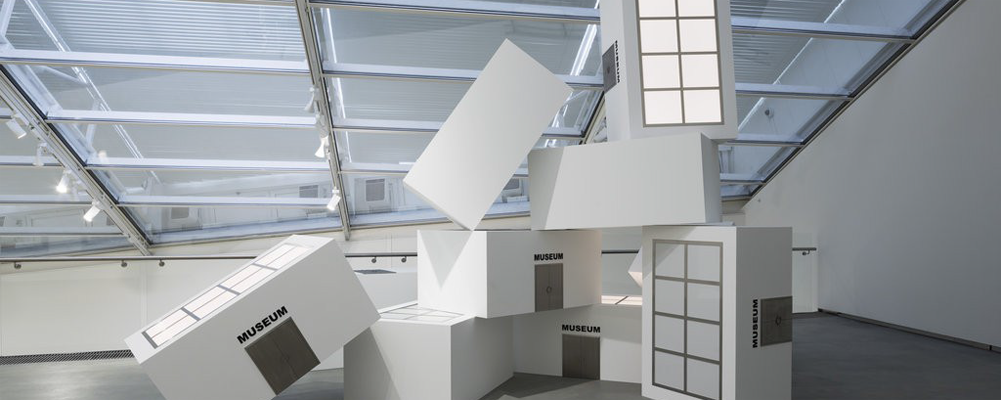
Elmgreen & Dragset, The Well Fair. Courtesy of the Ullens Center for Contemporary Art.
Elmgreen & Dragset, The Well Fair (2014), Ullens Center for Contemporary Art, Beijing
January 24–April 17, 2016
By constructing a fictional art fair inside a museum in this solo show, the Scandinavian artist duo Elmgreen & Dragset makes us (the “fair visitors) ponder about the issues of consumerism, power and desires in the art world in clever yet concise ways. Every details of their work (with their simple, clean aesthetics), displayed in the white rectangular booths, reflects their in-depth exploration of existing issues around and the structure of the ever-rapidly growing contemporary art market.
—Jessica Zhang
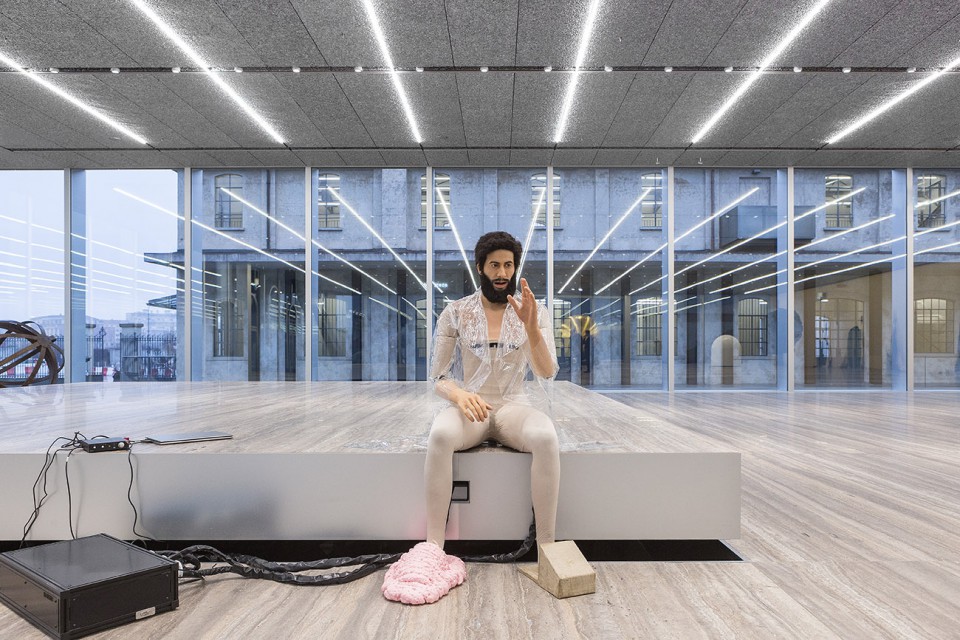
Goshka Macuga, To the Son of Man Who Ate the Scroll, (2016). Photo: Delfino Sisto Legnani Studio. Courtesy Fondazione Prada
Goshka Macuga, To the Son of Man Who Ate the Scroll (2016), at Fondazione Prada, Milan
February 4–June 19, 2016
Goshka Macuga took over the Fondazione Prada in Milan this past spring with a contemplation on a post-human future that doubled as a melancholic celebration of the greatness and beauty us faulty creatures are capable of. At the heart of the show—which featured works by fellow artists and ancient artifacts recast by Macuga in this context—was an android created by the artist and produced in Japan by A Lab.
The sculptural humanoid gesticulated with his arms calmly as he recited a speech pieced together from momentous texts by thinkers throughout history. As if programmed to preserve the vastness of human thought, the robot revealed flashes of self-reflection, wondering whom his speech was meant for. My first encounter with the soft-spoken humanoid-savant was in fact so memorable that I kept hearing “his” voice speaking to me days later.
When Macuga showed the work again at Berlin’s Schinkel Pavillon, she confided that finding the right voice actor for the piece was a big deal. The robot’s features, as I found out at the opening, suddenly standing in front of its human double, came from a handsome friend of the artist. Westworld episode seven, anyone?
—Hili Perlson
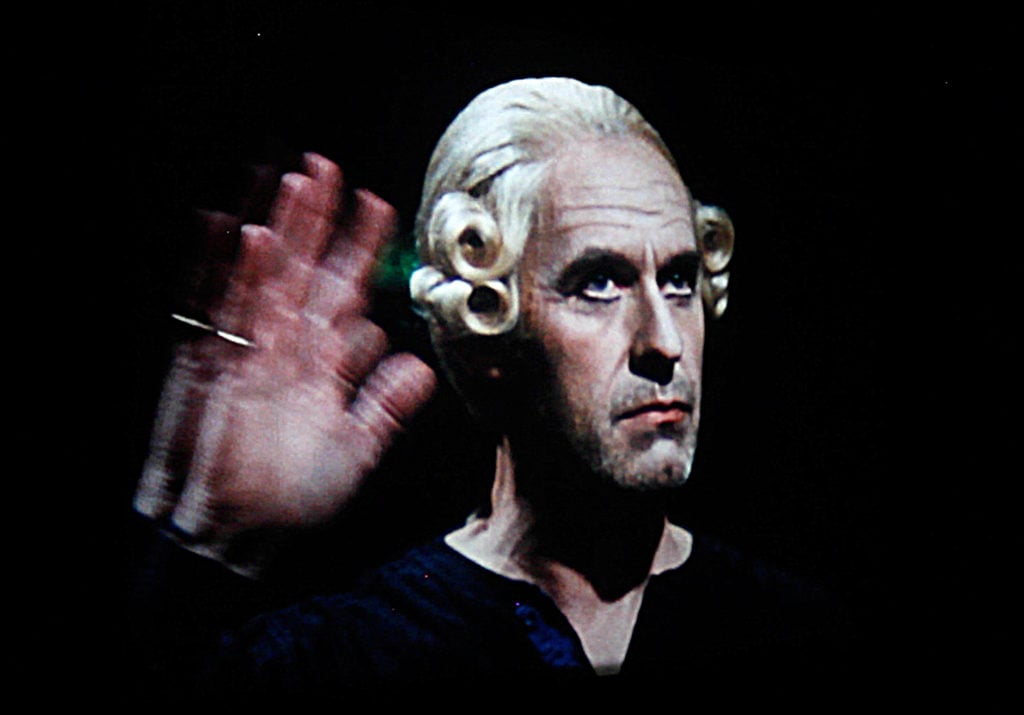
Tacita Dean, Event for a Stage. Courtesy of Marian Goodman.
Tacita Dean, Event for a Stage (2016), at Marian Goodman Gallery, New York
March 2–April 23, 2016
My pick would be Tacita Dean’s film called Event for a Stage, at Marian Goodman in March. It’s a compilation of clips of the actor Stephen Dillane performing a one-man show Dean prepared about the nature of theater. If that premise is easily grasped, the work’s actual content, and Dean’s treatment of it—both as it played out on the stage and then in her miraculous editing of the footage—are complex beyond belief. Let’s just say that the slippages between reality and fiction that all drama is built around are perfectly distilled into the 50 minutes of Dean’s film.
—Blake Gopnik
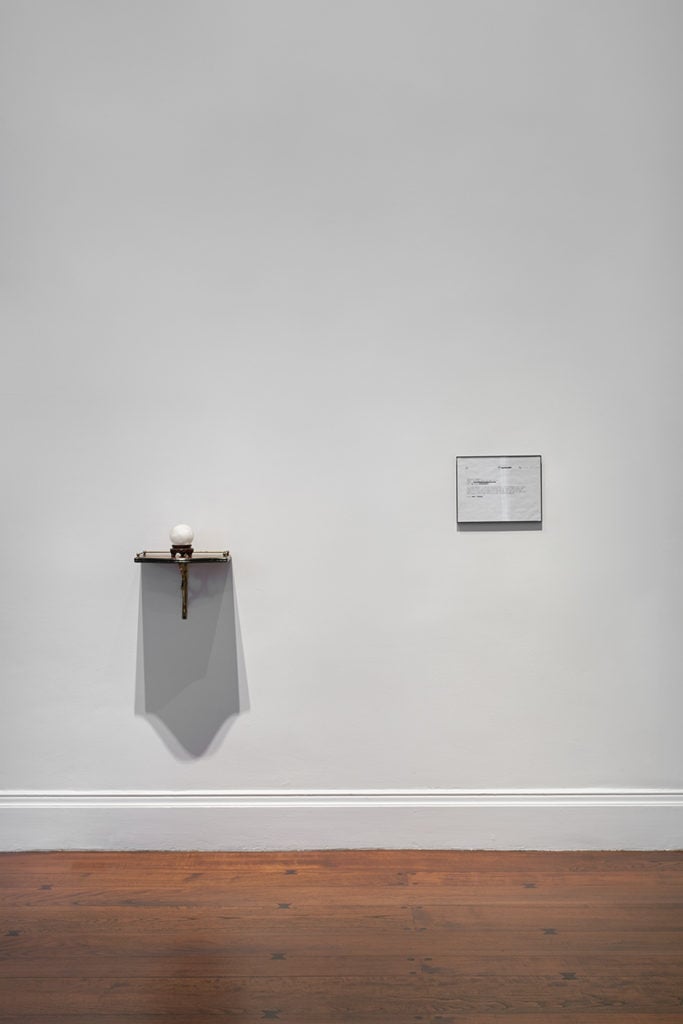
David Hammons, Untitled (2003). Photo Tom Powel Imaging, courtesy Mnuchin Gallery.
David Hammons, Untitled (2003) at Mnuchin Gallery, New York
March 15–May 27, 2016
The acclaimed “Five Decades” show at Robert Mnuchin’s gallery provided a museum-caliber survey of the work of the renowned artist. Perhaps Hammons’s most iconic work is a performance, Bliz-aard Ball Sale (1983), in which he sent up the art market by selling snowballs in various sizes on the sidewalk in New York’s East Village.
Hammons pushed the ideas behind the performance further in an untitled work from 2003, included in Mnuchin’s show, that you could almost have missed. It consists of a marble sculpture of a snowball resting on a thrift-store shelf, next to a printout of an email from a prospective (and anonymized) collector, pleading that she can’t see buying the actual snowball that was being offered her because she can’t find anyone who will insure it. And believe me, she wrote, I tried.
Since the show closed, reality TV star Donald Trump won the US Presidency and nominated one of his money men, the dealer Robert Mnuchin’s son Steven, an investment banker and hedge fund investor, to lead the Treasury Department. Ezekiel 18:20 says that “the child will not share the guilt of the parent, nor will the parent share the guilt of the child,” but we wonder if we’ll see another Hammons show at Robert’s gallery anytime soon.
—Brian Boucher
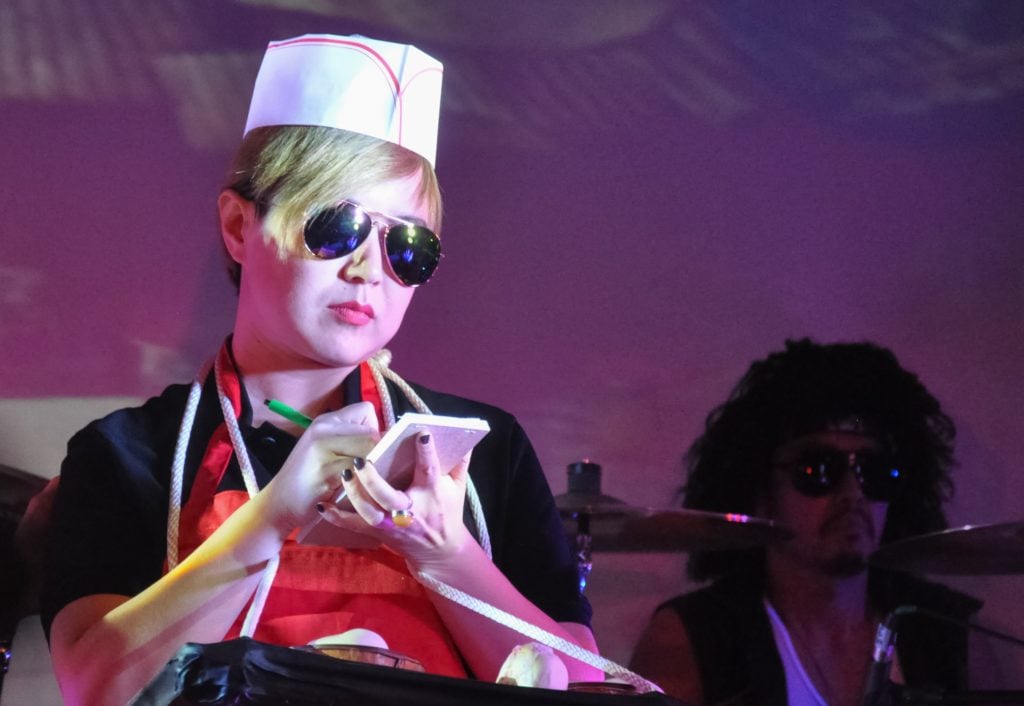
Cao Fei performing “Dim Sum Girl” with the Notorious MSG. Courtesy Cathy Fan.
Cao Fei at MoMA PS1
April 3–August 30, 2016
The Beijing-based artist’s first museum solo show in the US was a hit, especially during the opening weekend, when she employed the services of local hip-hop balladeers Notorious MSG in PS1’s oversize dome. In the museum, Cao Fei’s dystopian video and installation works reflected our fractured lives, from the awkward and endearing anime characters in 2004’s COSPlayers to China Tracy’s appearance in RMB City (2007). For Cao, a type of “resistant power” is needed to combat the modern condition, and this was fully on view at PS1 this year.
—Kathleen Massara
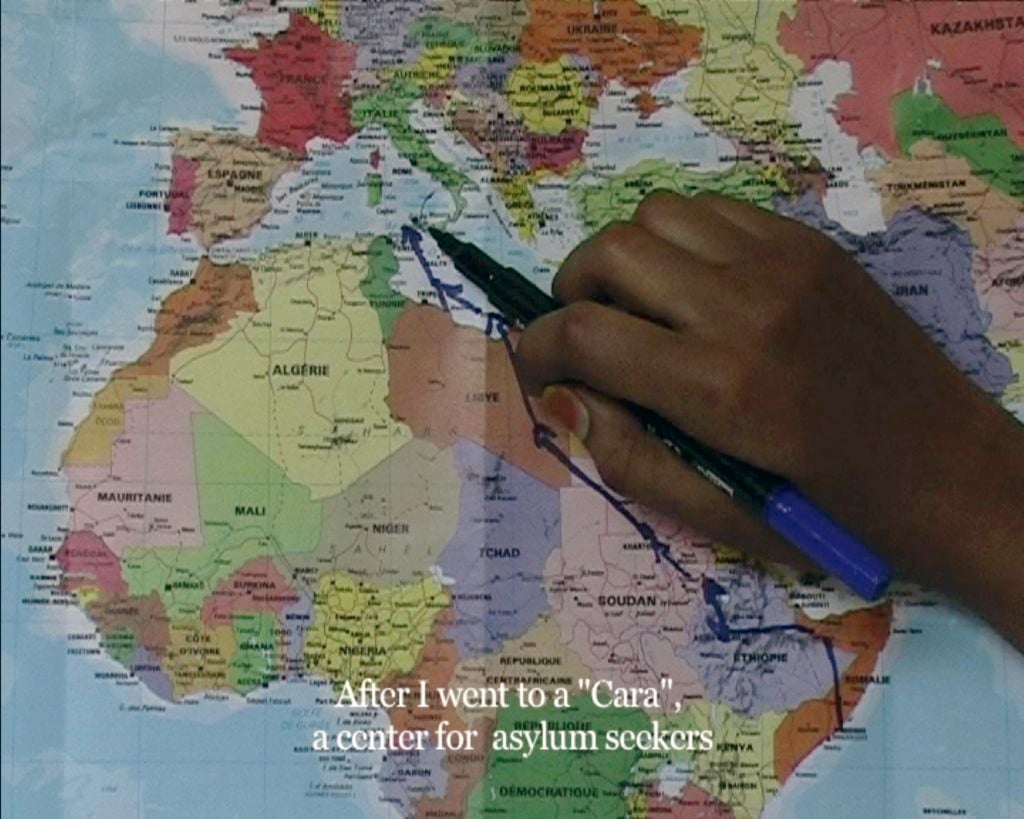
Bouchra Khalili, The Mapping Journey Project (2008–11). Courtesy of the Museum of Modern Art, New York. Fund for the Twenty-First Century, © 2016 Bouchra Khalili.
Bouchra Khalili, The Mapping Journey Project (2008–11), at the Museum of Modern Art, New York
April 9–October 10, 2016
I chose Moroccan French artist Bouchra Khalili’s The Mapping Journey Project , that was shown in the darkened atrium of the Museum of Modern Art. It consisted of eight large single-channel video screens in which individuals narrate and re-trace—by hand, with a dark marker on a map—nightmarish and often fruitless, illegal, cross-border journeys that are the result of displacement because of harsh political and economic circumstances.
Despite that the viewer does not see the face of the narrators—hearing just their voices methodically describing the how and why of the particular circumstances under which they lived, worked and moved around Europe, the Mediterranean and North Africa—each story is incredibly moving and personal, creating a collective portrait that reflects their precarious state as well as showing first-hand the impact of poverty and injustice on individual lives.
Mapping Journey is part of a larger, incredibly timely project at MoMA called “Citizens and Borders,” a series related to works in the collection that “offer a critical perspective on histories of migration, territory and displacement.”
—Eileen Kinsella
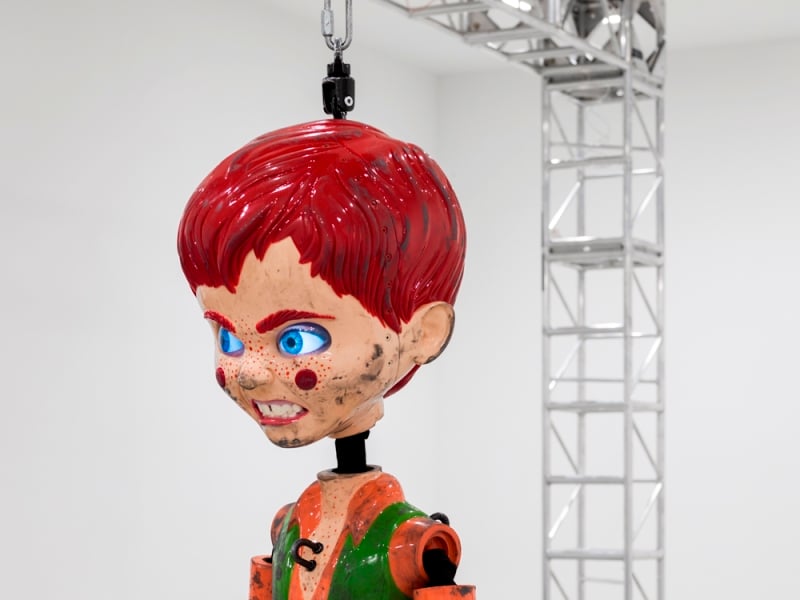
Jordan Wolfson, Colored sculpture, 2016, detail.
Photo Courtesy Sadie Coles HQ, London, and David Zwirner, New York.
Jordan Wolfson, Colored sculpture (2016), at David Zwirner Gallery, New York
May 5–June 25, 2016
It is not often that you can say with any certainly that an artwork, once seen, heard, and experienced, will never be forgotten. But one can quite safely make the claim for Jordan Wolfson’s monstrous, mechanical boy-wonder, Colored sculpture. A cross between Huckleberry Finn and Chucky, this robotic, painted-metal demon, chained to steel scaffolding, lunged to and fro across the room, and spastically crashed to the ground at irregular intervals. Terrorizing Chelsea gallery-goers last spring, the creature’s fiber-optic eyes followed visitors as they moved through the gallery space, thanks to facial recognition technology. Periodically, an ear-splitting passage from Percy Sledge’s 1966 hit, “When a Man Loves a Woman,” blasted from speakers to add a forlorn aspect to the puppet’s demeanor. In retrospect, this brilliant work seems prescient, perhaps embodying the anger and hyper-aggression that in the political arena at least, will forever characterize the year 2016.
—David Ebony
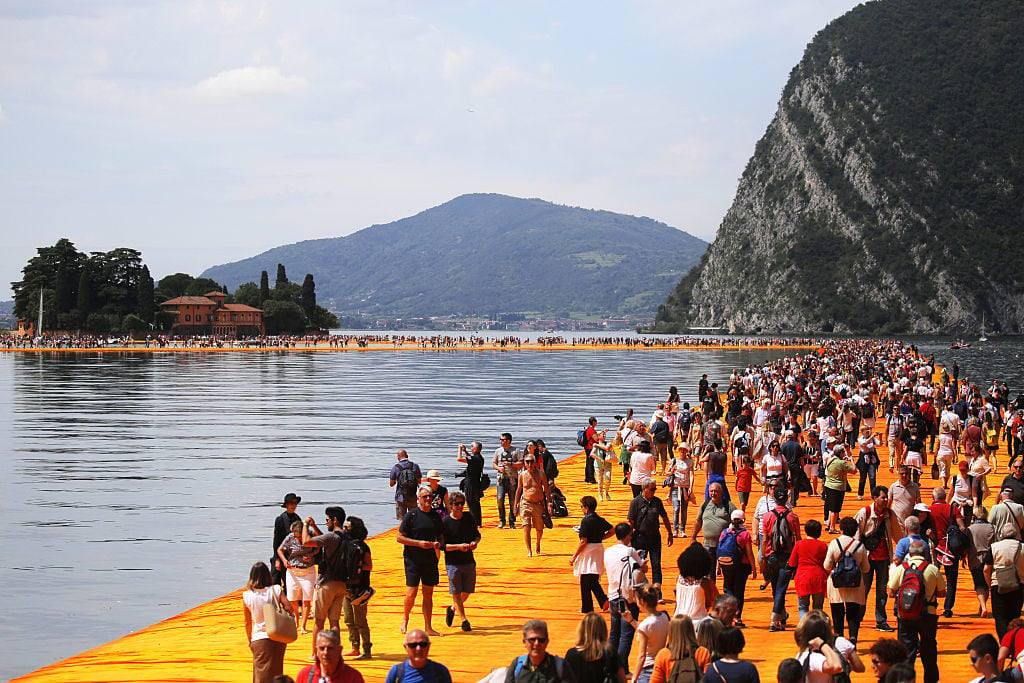
Visitor numbers to Christo’s Floating Piers (2016) overwhelmed local authorities. Photo: MARCO BERTORELLO/AFP/Getty Images.
Christo and Jeanne-Claude, Floating Piers, (2016) Lake Iseo, Italy
June 18–July 3, 2016
The artist Christo, for me, symbolizes a time when art was purely an exercise in imagination, he and his wife Jeanne-Claude conceived and realized magical interventions in fabric around the world, from New York, to Berlin, to Tokyo. Floating Piers, which took place in Lake Iseo, Italy, this summer saw the realization of the first of Christo’s works following the death of Jeanne-Claude after a ten year pause. For me, this is an honorable mention as after meeting Christo at his exhibition of preparatory works at Gmurzynska, St. Moritz in Switzerland in February of this year. (I never made it to Italy.) The preparatory works themselves were fascinating and his passion for the project was palpable.
In a year of tumult, the realization of Floating Piers was a Utopian oasis. Not only the was project visually stunning, appearing as a blaze of orange set against the beauty of the Northern Italian lakes, but at a time when Europe was essentially dividing, it built a bridge. Wrapped with the artists’ trademark fabric, the work created a walkway from Sulzano to Monte Isola for just three weeks. Created as art made purely for art’s, sake the work circulated like wildfire on social media, ensuring that Floating Piers touched many more than the lucky few who managed to make the trip to Italy to see it in reality.
—Amah-Rose Abrams
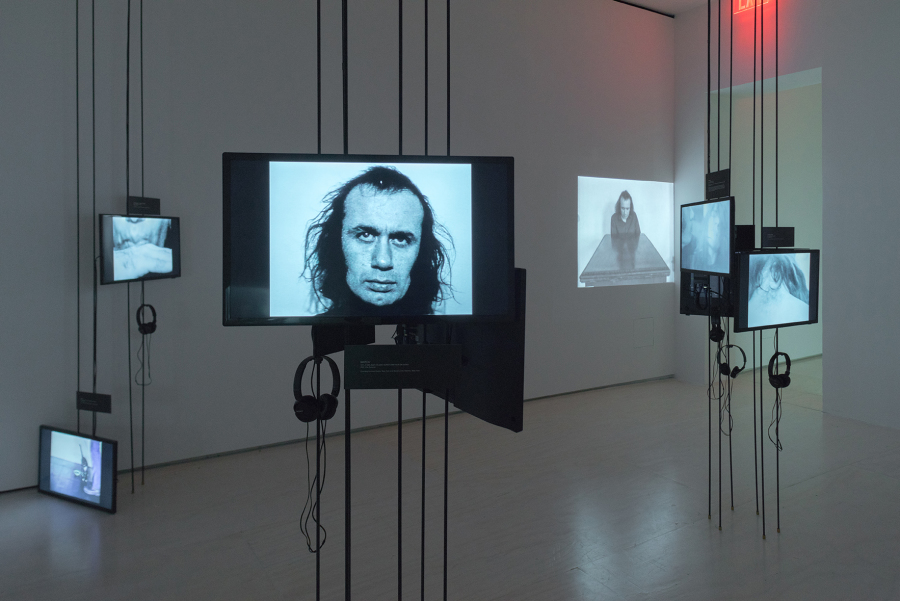
Vito Acconci, WHERE WE ARE NOW (WHO ARE WE ANYWAY?), 1976 (installation view). Courtesy of Acconci Studio and MoMA PS1, photo by Pablo Enriquez.
Vito Acconci, VITO ACCONCI: WHERE WE ARE NOW (WHO ARE WE ANYWAY?), 1976, MoMA PS 1
June 19–September 18, 2016
Vito Acconci’s extraordinary installation at MoMA PS1 last summer, “Open-Close,” dates from the 1970s. The work had to do with closure, and saw Acconci seal his anus shut with plaster in a tightly-framed close-up. In another scene, he was seen mushing a tomato onto his penis, thereby ripping it open. Acconci went to the heart of things, employing his body parts like Silly Putty, a malleable material to poke and provoke, physically and conceptually. A friend sent me an explicit still from the work, knowing that Vito had designed an exhibition space for me in the West Village in 2002. When I posted it online, it caused the shutdown of my Facebook account for months.
—Kenny Schachter
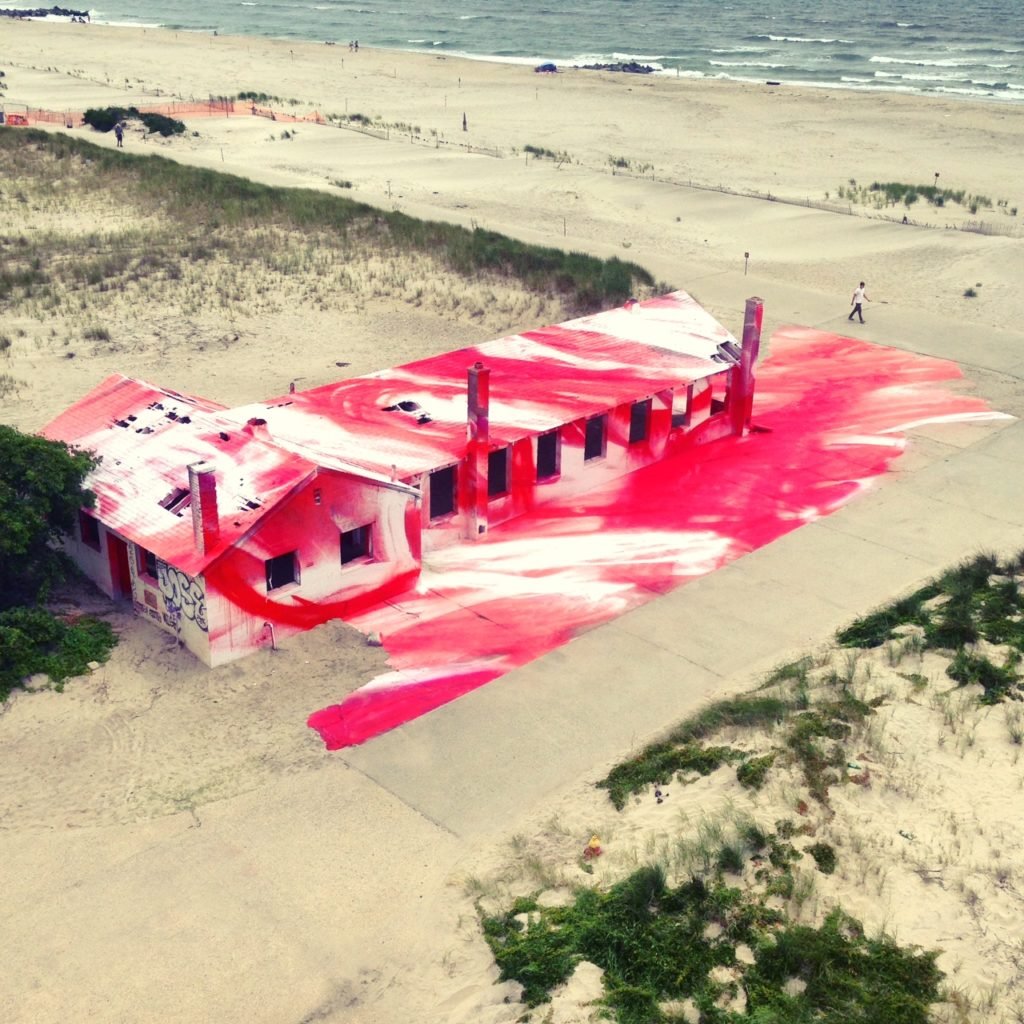
Katharina Grosse, “Rockaway!” Courtesy of Sarah Cascone.
Katharina Grosse, “Rockaway!” (2016), from MoMA PS1 at Gateway National Recreation Area at Fort Tilden, New York
July 3–November 30, 2016
I was surprised at how few works had stuck in memory after a long year covering galleries, museums, and art fairs, but Katharina Grosse’s inspiring site-specific spray painted mural on an crumbling, abandoned Army building out in the Rockaways stuck with me long after the summer heat had faded.
A meditation in white, pink, and red, the piece referenced the devastation of Hurricane Sandy, which rocked the surrounding area, and was meant to read like waves of paint crashing over the derelict structure. The work lent a surreal beauty to the space, which was slated to be destroyed following the exhibition’s run.
—Sarah Cascone
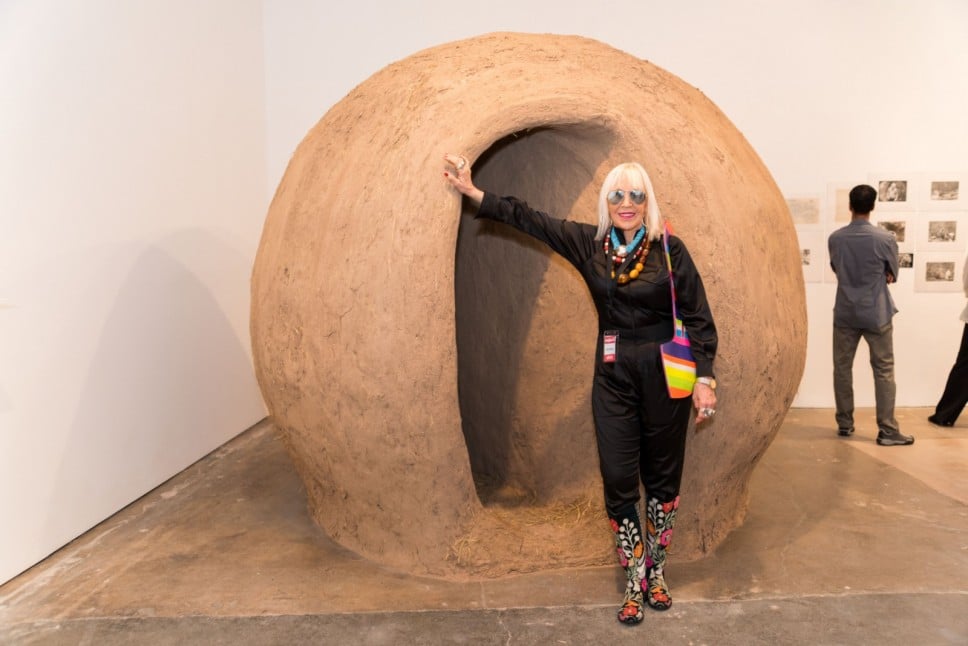
Marta Minujin with her installation in “Much Wider Than a Line.” Image courtesy SITE Santa Fe.
Marta Minujin, Comunicando con Tierra (1976), at SITE Santa Fe
July 16, 2016–January 8, 2017
If SITE Santa Fe’s biennial, “Much Wider In a Line,” didn’t quite add up to an overall statement, this was almost by design—it was organized by no less than five curators, debating the best framework to represent the Americas, with limited space. This project by the venerable Argentine artist Marta Minujin, however, came closest to a visual presence that somehow alluded to all the parts of an impossible-to-represent whole.
It is an homage to a 1970s project where Minujin was granted permission to extract 30 kilos (about 66 pounds) of earth from the Inca site of Machu Pichu in Peru. She then shipped it to Buenos Aires, where one portion of the soil was elaborated into a colossal bird’s nest (recreated here), the other portion sent to fellow artists across the continent ,who then sent back soil of their own, to be, at last, remixed with the soil of Machu Pichu, and returned to the site with what she called a “ceremony of restitution.”
—Ben Davis
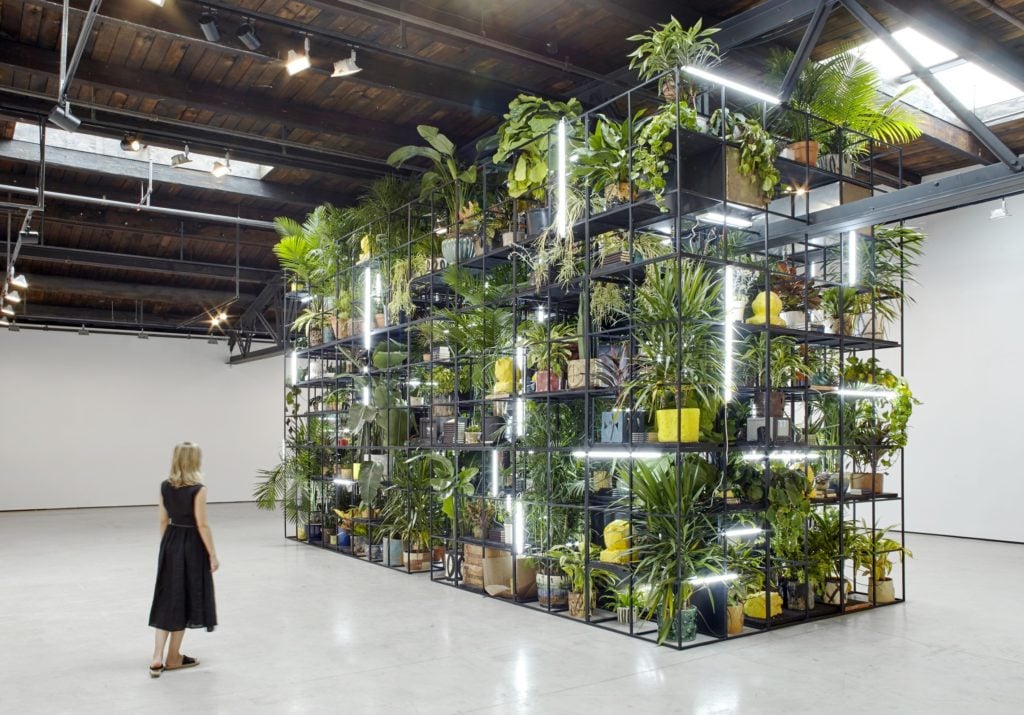
Installation view, Rashid Johnson, Fly Away (2016). Photo: Martin Parsekain © the artist, courtesy of Hauser & Wirth, New York.
Rashid Johnson, Antoine’s Organ (2016), at Hauser & Wirth, New York
September 8, 2016—October 22, 2016
The centerpiece of Rashid Johnson’s highly rated September solo exhibition at Hauser & Wirth’s enormous New York space, Antoine’s Organ consists of a large scaffolding-esque installation filled with greenery, potted plants, and Afro-American paraphernalia. These included signature items from Johnson’s oeuvre such as lumps of shea butter, ceramic pots, video monitors, books, and a piano periodically played by the musician Antoine Baldwin.
Johnson’s use of carefully-selected and deeply personal objects amid the greenery not only explored poignant notions of race relations in America: the installation is simultaneously an assault on the senses, activating not only the visual, but also the senses of smell and sound, facets that are amplified by the artwork’s imposing scale. Johnson successfully traverses the precarious line between art that is political and beautiful at the same time with bravado.
—Henri Neuendorf
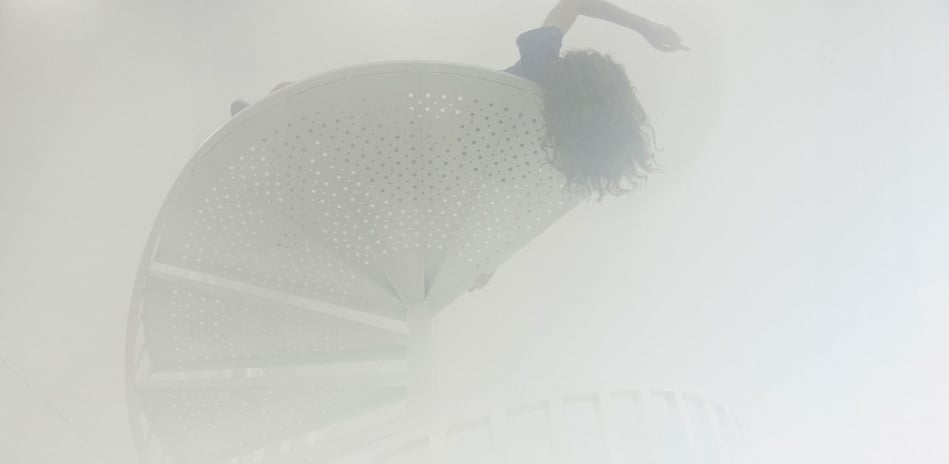
Eliza Douglas in Anne Imhof, Angst II (2016) at the Hamburger Bahnhof Museum für Gegenwart, Berlin. Photo ©Nadine Fraczkowski.
Anne Imhof, Angst II (2016), at Hamburger Bahnhof during Berlin Art Week
September 15–18 and 22–25, 2016
German artist Anne Imhof’s “opera in three acts” unfolded in three cities this year, beginning with part one at Kunsthalle Basel in June, taking over Berlin’s Hamburger Bahnhof in September, and finally appearing at La Biennale de Montreal in October. The durational performances comprised a handful of bored-looking, waif-like actors in vintage band t-shirts, taking (optional) instructions from Imhof via text message. Fog machines, remote-controlled drones, and falcons were also key players.
Performers moved according to gestures lifted from club bouncers and fashion models, headbangers and iPhone addicts. In Berlin, the climax of the opera included a tightrope, and white spiral staircases leading to nowhere inside the Hamburger Bahnhof’s cavernous main hall. While one performer climbed and descended, others drank Coca Cola in a side alcove. Over here, a duo covered each other in shaving cream; over there, someone lit a cigarette. The seemingly aimless actions began in one corner, attracting a crowd that was soon distracted by a screeching noise or a soft serenade across the hall. The immersive array of action, however, was less chaotic than it was melancholic, nostalgic, and—well—angsty, but with an uppercase “A,” in its particularly German sense.
—Alyssa Buffenstein
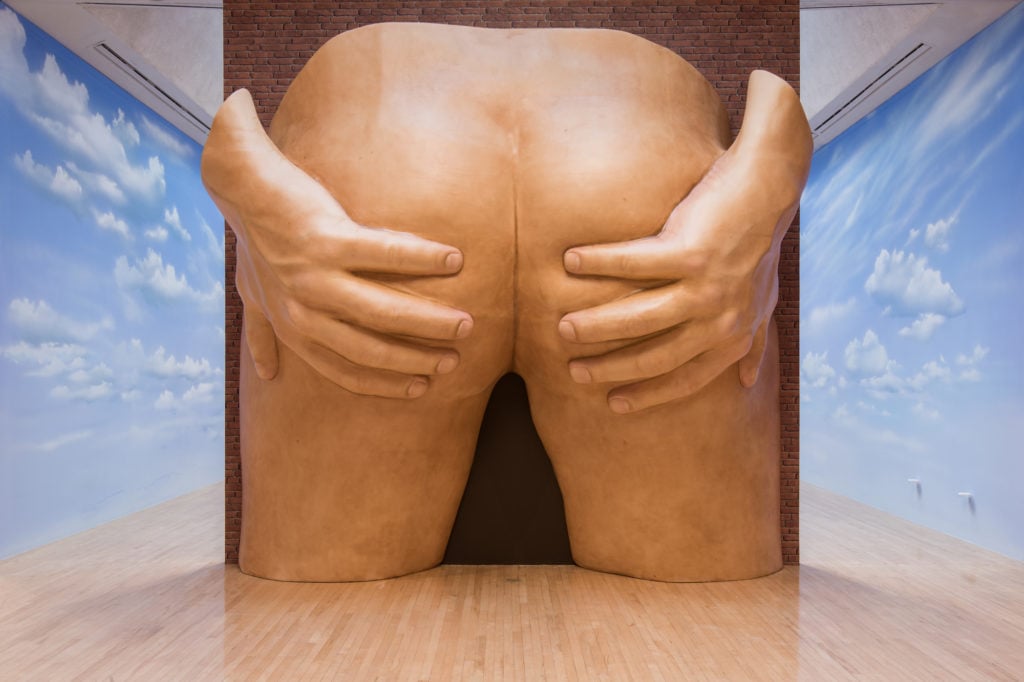
Anthea Hamilton’s Project for a Door (After Gaetano Pesce) at the Turner Prize 2016. Courtesy Joe Humphrys ©Tate Photography.
Anthea Hamilton, Project for Door (After Gaetano Pesce), 2015, at Tate Britain, London
September 27, 2016–January 2, 2017
Anthea Hamilton’s homage to Italian designer Gaetano Pesce (who first designed this never-realized door project in 1972) was first seen at the SculptureCenter in New York last year, making the rounds in Instagram feeds. But it was when it was installed at Tate Britain in London this September, as part of Hamilton’s Turner Prize 2016 show, that it became a total media sensation.
In the end, and despite the furor and relentless coverage, Hamilton did not win the Turner Prize, which went to this year’s hottest artist in the UK, Helen Marten. But if there was prize for the most Instagrammed artwork somewhere, she would have definitely been one of the strongest contenders. Her Project for a Door is emblematic of a new type of work that exists beyond the traditional categories of judgement (good, bad, beautiful, ugly…) and whose value resides, mostly, on its social media appeal and rapid circulation. Those works which, love ’em or hate ’em, are seemingly everywhere online.
—Lorena Muñoz-Alonso
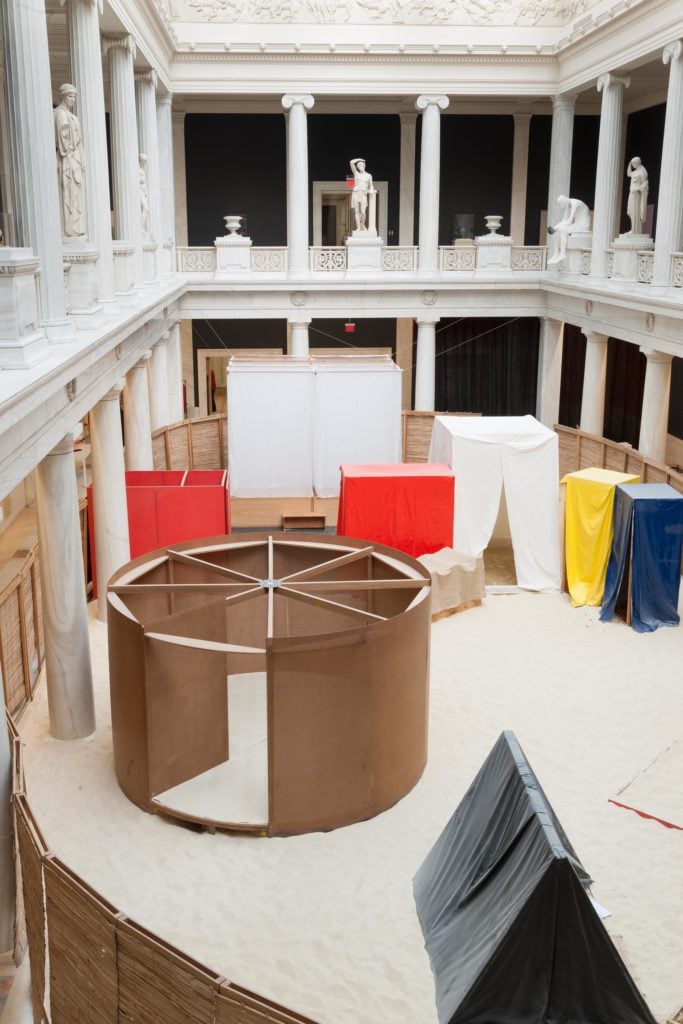
Installation view of Eden in “Helio Oiticica: To Organize Delirium” at the Carnegie Museum of Art. Image courtesy Carnegie Museum of Art.
Hélio Oiticica, Eden (1969), at the Carnegie Museum of Art, Pittsburgh
October 1, 2016–January 2, 2017
The most ambitious passage of the Carnegie’s ambitious Hélio Oiticica show, “To Organize Delirium,” packing the entirety of the museum’s Hall of Sculpture. Eden recreates the heart of the Brazilian interactive art pioneer’s 1969 Whitechapel retrospective, made in the interregnum between the intensification of the Brazilian dictatorship and Oiticica’s long self-imposed exile in New York. The beach-like environment, full of pavilions that let you explore elemental substances, a quixotic prototype for his idea of “creileisure,” that is, creativity and leisure united, the former freed from its professionalization and the latter freed from passive consumption. It has the brainy appeal of high conceptualism and intuitive pleasures of a playground.
—Ben Davis

A coalition of artists and activists shrouding Equestrian Statue of Theodore Roosevelt outside the American Museum of Natural History, which depicts the 26th president of the United States flanked by a Native American and an African American man. Image: Ben Davis.
MTL+, “Respect. Remove. Rename” tour (2106), at the American Museum of Natural History, New York
October 10, 2016
The collective MTL+’s residency at Artist Space has received plenty of attention by now, serving as a kind of lending library for artistic protest banners and turning the downtown alternative art venue into a continuous program of activist workshops. Their most public initiative came on Columbus Day, as some 200 people gathered at the American Museum of Natural History for a rowdy, festive, and righteous “alternative” tour of the exhibits, complete with its own official pamphlet, with members of the collective and activists from Black Lives Matter, New York Stands With Standing Rock, and others pointing out content full of subtle and not-so-subtle colonial rhetoric, and badly in need of updating. Good art changes the way you see the world. This certainly changed the way that I see the American Museum of Natural History.
—Ben Davis
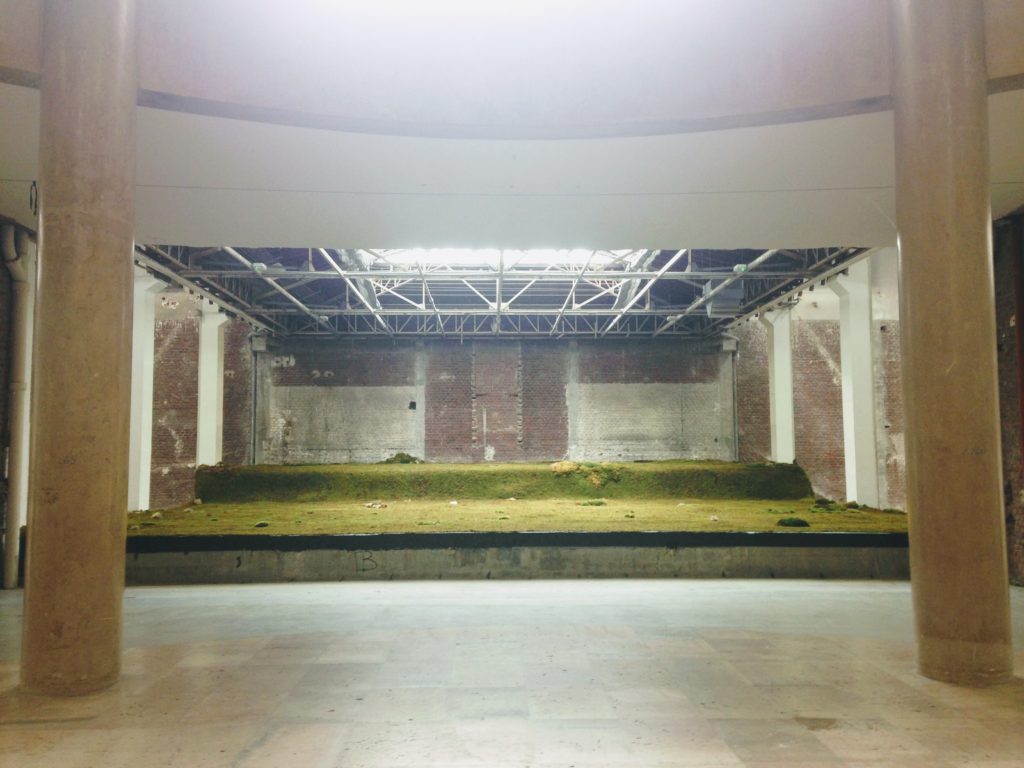
Tino Sehgal, 2016, “Carte blanche to Tino Sehgal,” Palais de Tokyo, Paris. Courtesy of Caroline Elbaor.
Tino Sehgal, “Carte blanche to Tino Sehgal,” (2016) at Palais de Tokyo, Paris
October 10—December 18, 2016
As the exhibition’s title may suggest, Tino Sehgal was given free reign in designing the largest exhibition of his work to date, which featured over 300 performers scattered throughout the sinewy, labryinth-like Palais de Tokyo in Paris.
Under Sehgal’s guidance, the show featured several of the artist’s major works—known particularly for their audience involvement—thereby immersing visitors in his vision. And as is often the case with his work, the distinction between performer or audience member was hard to discern.
Upon entering, I was immediately approached by a dancing man who posed the question: “What is the riddle?” Deeper into the space, the venue suddenly appeared to be vacant, abandoned, save a patch of rolling grass installed in the main entryway. Suddenly, a bevy of running dancers came parading full-throttle through the space like a pack of wildebeasts. Visitors stepped aside to avoid collisions.
The key to experiencing “Carte Blanche to Tino Sehgal” lay in the willingness to open random doors, behind which you would find a child reciting a monologue, or to wander around the dilapidated corners of Palais de Tokyo and discover a pitch-black room full of chorus members singing in haunting unison.
—Caroline Elbaor

Untitled, 2004. © 2015 Agnes Martin / Artists Rights Society (ARS).
Agnes Martin, Untitled (2004), at the Guggenheim, New York
October 16, 2016—January 11, 2017
I have yet to read a wholly satisfying account of Agnes Martin’s exhibition at the Guggenheim; nor did the show seem able to contain itself in any meaningful sense. Such a thing was perhaps beyond the sight line of the possible, the one set and reset by Martin’s paradoxical (and therefore impossible) lines. Within minutes of entering the museum it became obvious that ready-made angles of interpretation—biographical, subject vs. object, ideas of linear formal progression—would fall away like accidents that reveal a substance. But what was revealed: a personal story, a subject, a string of objects, a narrative? Not at all. Yet when I found myself at the exhibition’s final painting—Martin’s penultimate existing work, the one she didn’t destroy—something came together for me. Or rather something ended: Martin allows for a glimpse into the last moments of a strange inner deity, one that extinguishes itself, on time, in a silent din of thunder.
—Jonathon Sturgeon
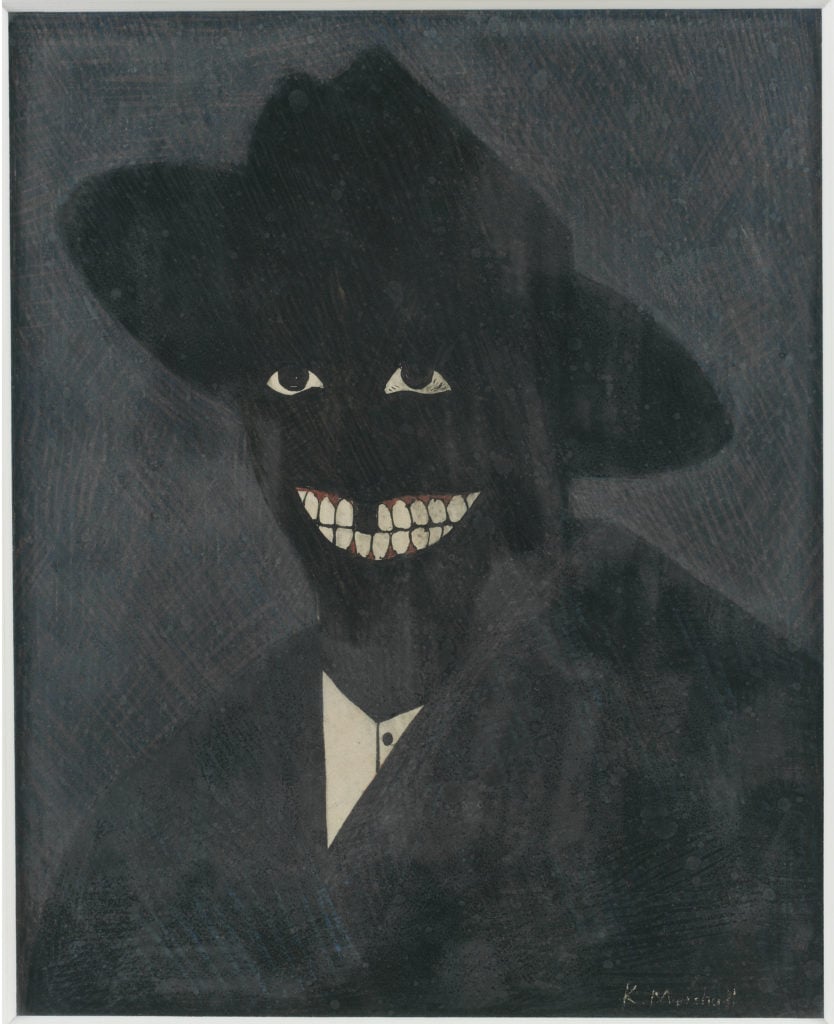
Kerry James Marshall, A Portrait of the Artist as a Shadow of His Former Self (1980). Courtesy of the Metropolitan Museum of Art.
Kerry James Marshall, A Portrait of the Artist As a Shadow of His Former Self (1980) at the Met Breuer, New York
October 25, 2016–January 29, 2017
One of the most important pictures to ever be made in America is on view currently at the Met Breuer: Kerry James Marshall’s A Portrait of the Artist As a Shadow of His Former Self (1980). Painted just two years after Marshall left art school, the tiny picture (it measures just eight-by-six inches) makes visible the historical invisibility of the African-American experience through the use of cruel white stereotype. This “self-portrait,” which is really the unflinching portrait of a nation, is also art’s best jujitsu move since Velázquez painted the inbred features of Spain’s King Phillip IV.
—Christian Viveros-Faune
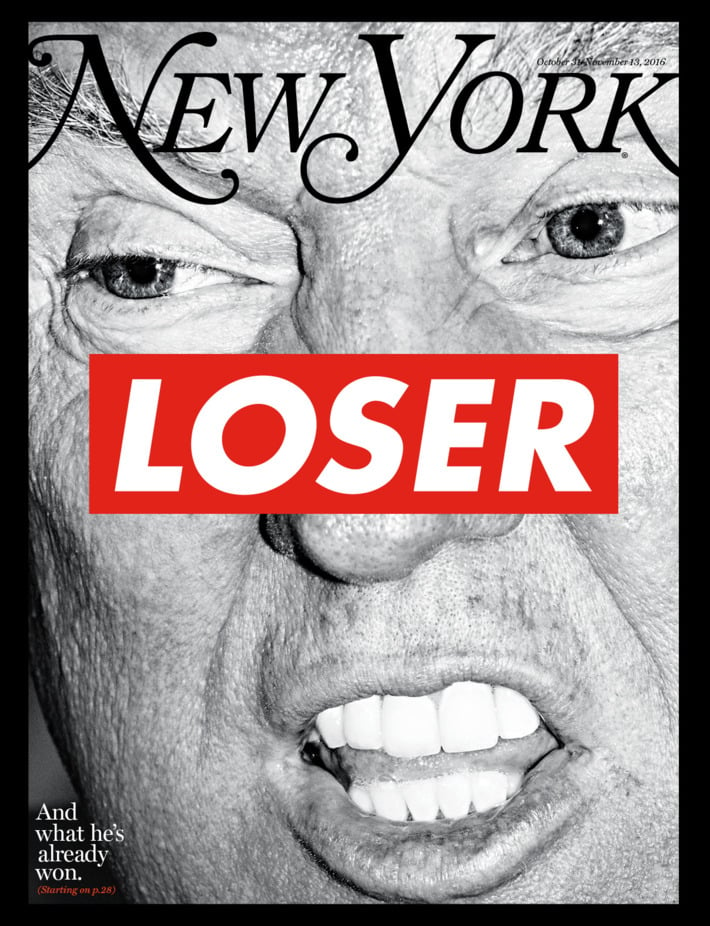
Election Issue cover. Art by Barbara Kruger for New York magazine. Photograph by Mark Peterson/Redux.
Barbara Kruger, New York Magazine Election Issue Cover
October 31, 2016
One of the most important artworks of the year didn’t appear at a major museum or gallery, but in the pages of a old-fashioned print publication. In the final days before a election that everyone predicted would be won handily by Hillary Clinton, Barbara Kruger produced a powerful cover for New York magazine, a tight close-up of Donald Trump’s face emblazoned with the word “Loser.”
At the time of its release, NY mag editor Adam Moss admitted it could be interpreted as an election prediction, but insisted the image had multiple levels of meaning. “Donald Trump has a keen instinct for locating the most vulnerable place in the character of anyone who disagrees with him—my labeling him with the word he most feared was just a comment on and reenactment of that strategy,” Kruger explained following the reality star’s unexpected victory.
To me, Kruger’s jab isn’t made any less powerful by Clinton’s defeat. As a resident of a city that many have accused of being a liberal bubble, I feel it’s all the more important to stand behind the sentiment her work represents: that this is a man unfit to serve, and that his win is America’s big loss. It reminds me that artists will have a lot to do over the next four years, and galvanizes me to stand with them to defend all that is right and just in American democracy.
—Sarah Cascone
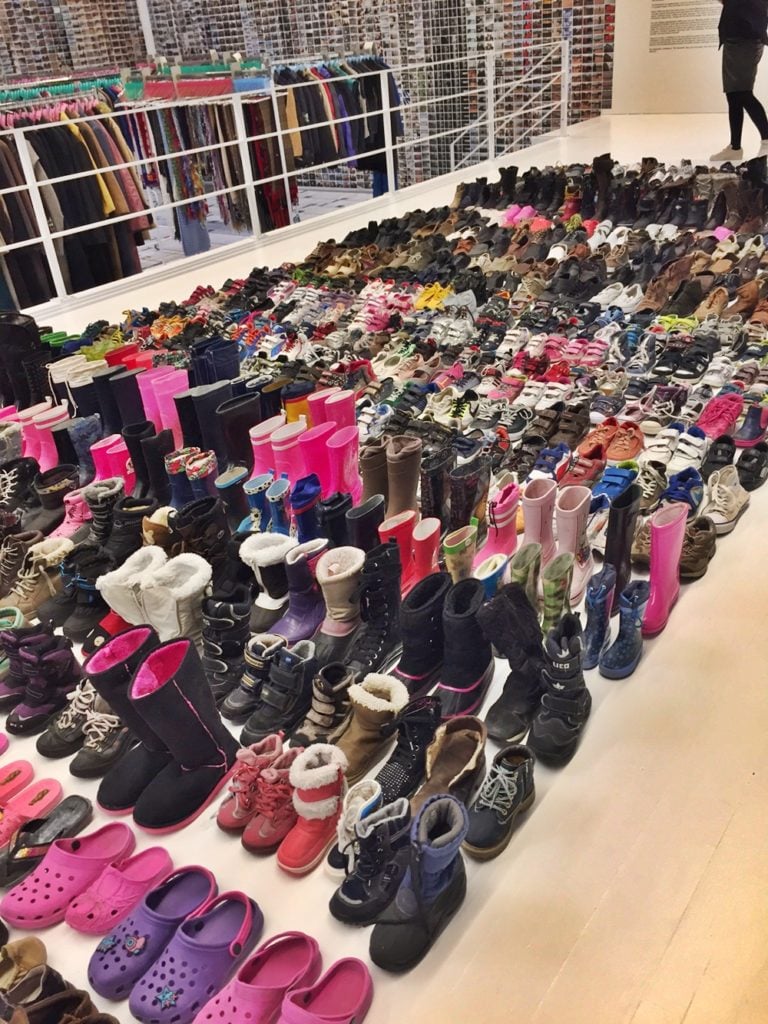
Ai Weiwei, “Laundromat” at Deitch Projects. Courtesy Eileen Kinsella.
Ai Weiwei, “Laundromat” (2016), at Deitch Projects, New York
November 5–December 23, 2016
Delving into a similar topic, an honorable mention to Ai Weiwei’s for his four simultaneous New York shows that explore issues of survival amid displacement and destruction brought on by war, violence and oppression. “Laundromat,” in particular, at Deitch Projects in Soho, addresses the plight of hundreds of thousands of refugees who once occupied the makeshift Idomeni camp on the Greece-Macedonia border. After receiving his passport back from Chinese authorities in 2015, Ai traveled to Berlin, where he met refugees who had just arrived from Syria. In an effort to understand the situation and scope of the crisis, he visited the Moria refugee camp in Lesbos. “I saw how the refugees arrived on the Greek shore, many of them women and children. The conditions at the camp were shocking,” said Ai. More recently he visited Idomeni, where he also extensively documented the harsh, inhumane conditions through photographs and other ephemera he collected. A focal point of the “Laundromat” show is the thousands of personal items of clothing—pants, coats, blouses, shoes, boots—that he carefully collected and laundered as a way of humanizing and paying tribute to the refugees who were forced to move on and leave these items behind.
—Eileen Kinsella
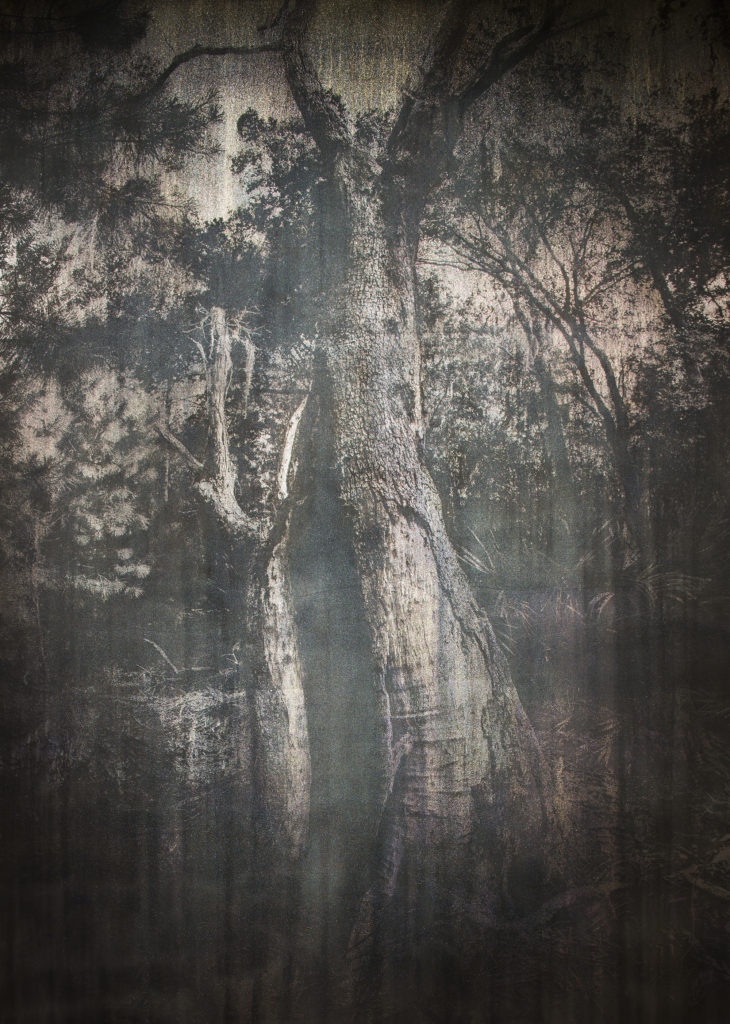
Michael Joo, Entasis (phloem), 2016, “Barrier Island.” Courtesy of SCAD Museum of Art, photography by John McKinnon.
Michael Joo, “Barrier Island” (2016) at the Savannah College of Art and Design Museum of Art
November 10, 2016–February 5, 2017
As great as it is to see art in museums, galleries, fairs and private collections, the best part of writing about art is being invited to an artist’s studio. I saw a lot of beautiful things in 2016, but it was very poignant to visit Michael Joo’s studio in the Red Hook area of Brooklyn as he was finishing paintings and sculptures for his solo exhibition “Barrier Island” at the museum of the Savannah College of Art and Design.
Here’s why… Joo explores the effects and interplay of natural phenomena and human intervention on landscape, and how these forces shape cultures and identities. The works for this show were inspired by coastal Georgia, most especially Sapelo Island, a barrier island and nature reserve. The artist had embedded himself there for research and to capture the photographic elements of which his new paintings are comprised. Unfortunately and ironically, right before his show was to open, Hurricane Matthew hit the area, causing the very kind of chaos and damage to the communities of the region that he explores in his work, and delaying the opening of his exhibition.
—Laura van Straaten

Shaun Leonardo, I Can’t Breathe (2016). Courtesy David Willems Photography.
Shaun Leonardo, I Can’t Breathe (2016), at Cooper Union
November 11, 2016
Shaun Leonardo’s performance brought together tragedy and urgency in a self-defense workshop-cum-performance that he’s staged at various other venues, including this past March at the Volta art fair as well as at community centers in African-American neighborhoods.
The title, of course, refers to the last words of Eric Garner, an unarmed African-American man who died in a police chokehold on Staten Island. Nationwide protests resulted when no indictments resulted from what a medical examiner ruled to be a homicide.
A commanding presence, Leonardo taught participants, including me, how to evade or block offensive moves including a chokehold as a few dozen people looked on. The sadness and perhaps even impotence of the performance were poignantly clear when Leonardo pointed out that Garner himself used one of the evasive moves Leonardo was teaching us; these techniques, he pointed out, qualify as resisting arrest and thus are bound to escalate matters if used against aggressive cops.
As participants practiced blocking a punch and escaping from a headlock and a stranglehold, there was a certain amount of awkward levity. When the final lesson began, in which we put one another in chokeholds, the room was painfully silent, save Leonardo’s deep voice, reading a text about fear by Nina Simone and intoning, eleven times, Garner’s final words. As my participant-partner’s forearm pressed against my windpipe, I gained a new appreciation for the way that an artwork can, if you’ll pardon the expression, grab you by the throat.
—Brian Boucher
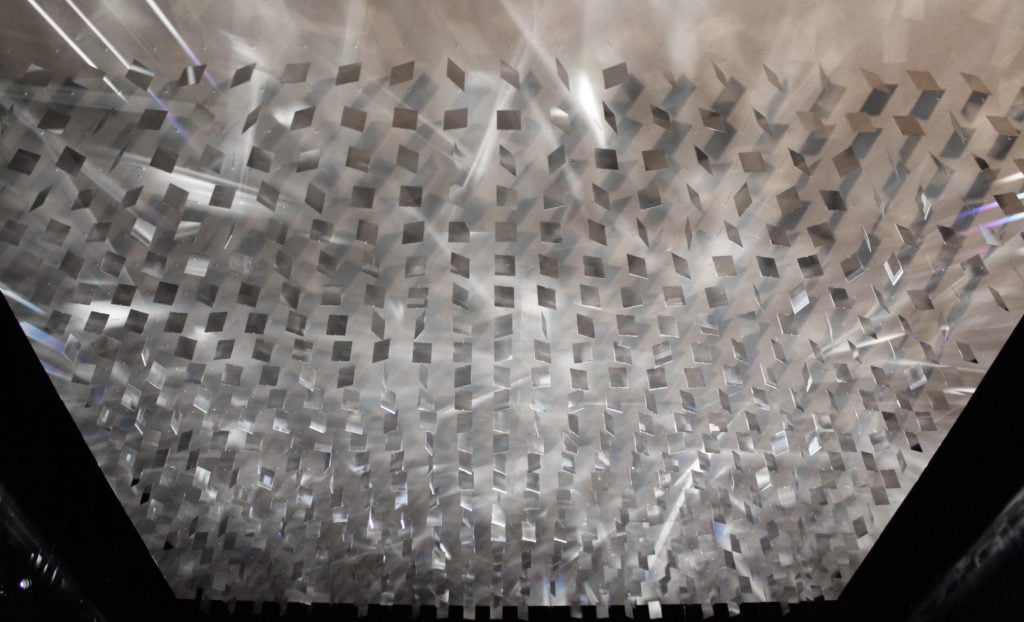
Julio Le Parc, Continuel-lumière au plafond (Continuous-Light on Ceiling) (1963/2016.) Installation view: Julio Le Parc: Form into Action, Pérez Art Museum Miami, 2016–17. Courtesy of the Pérez Art Museum Miami.
Julio Le Parc, Continuel-lumière au plafond (1963/2016) at the Pérez Art Museum Miami
November 18, 2016–March 19, 2017
From its very first work, a shimmering curtain of rotating reflective squares, casting constantly-shifting beams of light across the space—Continuel-mobile, originally created for the third Paris Biennale in 1960—“Julio Le Parc: Form Into Action” was an utterly mesmerizing experience. There was the seemingly-endless rainbowed ribbon of his ten-part canvas La Longue Marche (1974), the mirrored fun house maze that was Cellule à pénétrer (1963/2016), and the seizure-inducing Cellule avec projection en vibration (1968/2016).
Amid the nonstop party/art slog that is Miami Art Week, the Estrellita Brodsky-curated exhibition offered moments of pure childlike delight—try seeing the world through a pair of ingenious slatted Le Parc glasses and see if you don’t smile—as well as quiet reflection, as when I paused to lay beneath Continuel-lumière au plafond, watching the light bounce off in ever-changing patterns from mirrored squares hung from a grid on the ceiling. With every piece on view, I just wanted to keep looking.
This is an artist with a rare vision, who uses a simple palette of colors and basic mechanical parts to create utterly unexpected, transformative works that engage the viewer on multiple levels. They are beautiful, thought-provoking, and easily appreciated both by the art cognoscenti and the everyman. It’s unbelievable that it’s taken this long for the 88-year-old to get a US museum show, but now that it’s here, you owe it to yourself not to miss it.
—Sarah Cascone
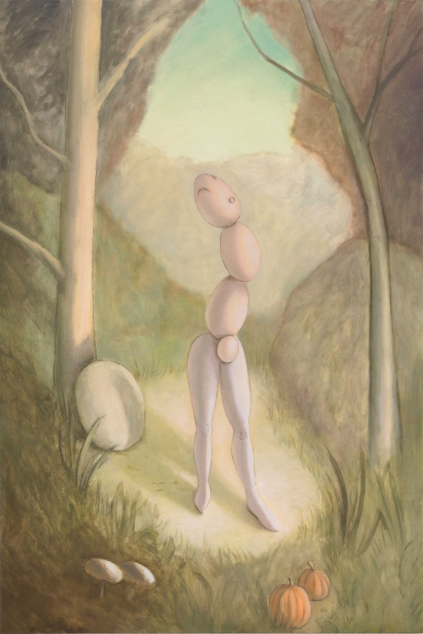
Anna Glantz, Chanteuse (2016). Courtesy of 11R.
Anna Glantz, Chanteuse (2016), at 11R, New York
December 8, 2016–January 15, 2017
It’s a struggle to recall an entire year of art, let alone settle on just one piece, so I’ll go with a brand-new painting I just saw and can’t get out of my head. Anna Glantz’s sneaky and whimsical Chanteuse represents just one facet of this young artist’s rollicking, zig-zag practice, and brings a way funnier and more engaging approach to representation than I can remember seeing in a long time.
There seems to be more painters working with pictorial space and picking up the mantle of goofy figuration than there were just a few years ago—a good thing!—but that doesn’t mean that many have managed to carve out such idiosyncratic and memorable voice like Glantz has. Her work seems to hinge on moments of transformation, and this slippery eel-faced mannequin is even better in context.
In the artist’s current solo show at 11R in the Lower East Side, you turn the corner and wham, suddenly you’re in fairy tale forest more surreal and precise than any dream I can remember having. After feeling like the past month has been a waking nightmare, I really needed a reminder of better kinds of dreams.
—Tatiana Berg
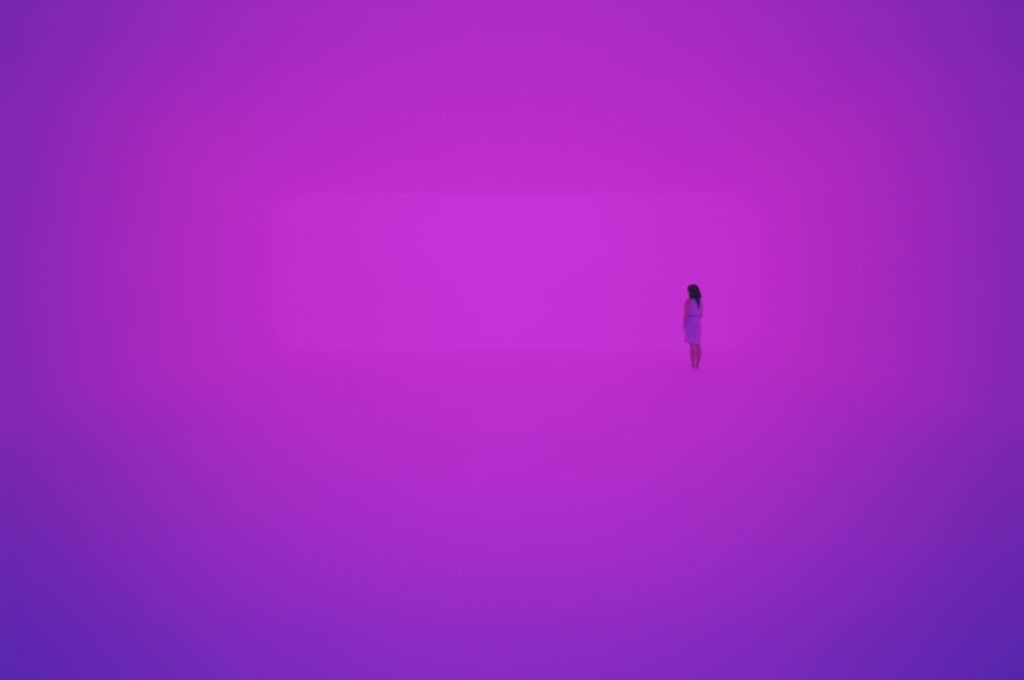
James Turrell, Breathing Light (2013). Courtesy of the Los Angeles County Museum of Art, © James Turrell, photo © Florian Holzherr.
James Turrell, Breathing Light (2013), Los Angeles County Museum of Art
Ongoing
James Turrell never disappoints. I’m an avid Turrell lover, and Breathing Light at LACMA did it for me. The walk-in work of pure color, eliminating depth perception, created a surreal and intimate experience. A white rectangular room with curved corners, flooded with electric colors, driven by a sequence of changing lights, was everything Turrell does so well.
—Astyaj Ghassemi Bass